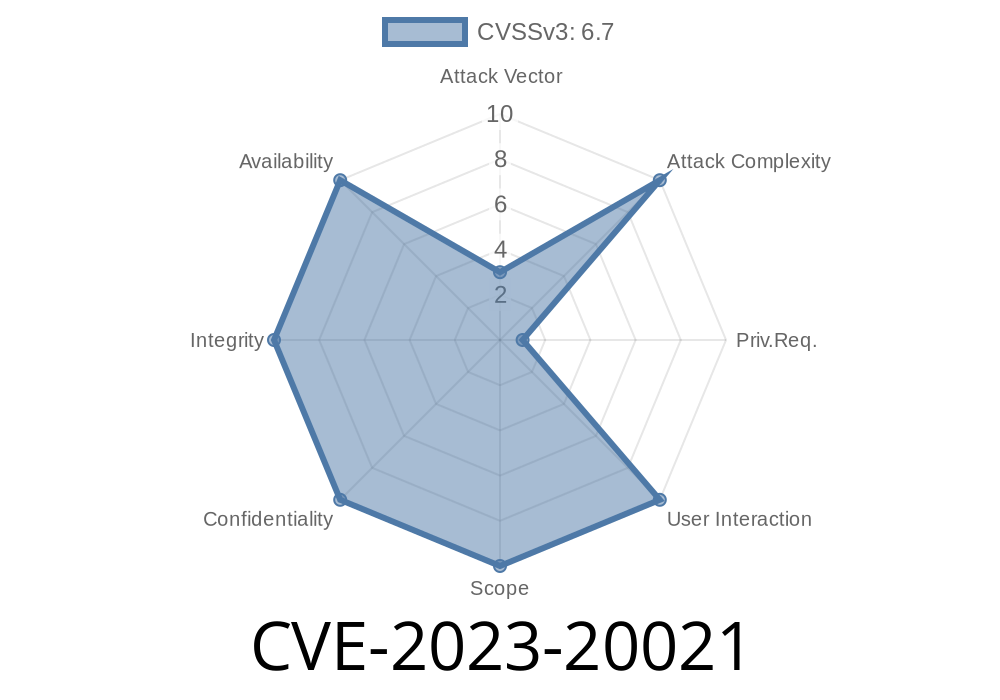In this in-depth post, we'll break down CVE-2023-20021, a serious security vulnerability that hits Cisco Identity Services Engine (ISE). This bug lets attackers, who already have admin access, run any command on the system as root—opening the door to total system compromise. We'll explain exactly how this works, show real code snippets, and guide you through how attackers might use this flaw. All info is written in straightforward American English for everyone to grasp.
[References and Further Reading](#references)
Overview of Cisco ISE and CVE-2023-20021
Cisco ISE is a widely-used network security policy management and access control platform, powering secure access in networks around the world.
CVE-2023-20021 is a group of vulnerabilities in some ISE CLI commands where user-supplied input isn’t properly validated. This mishap allows an attacker with admin privileges to execute command injections—letting them run system-level commands as root. What's scary here isn't just the bug itself, but the fact that it can be used to *completely take over* the underlying operating system.
Impact: Privilege Escalation to full root access
Attackers Need: Administrator CLI login (local or through SSH).
- Why It’s Serious: Privilege escalation can lead to total system control, data theft, or as a beachhead for wider network attacks.
How the Vulnerability Works (With Code Samples)
These CLI command(s) fail to sanitize user input. So, when the CLI passes that input further to the underlying shell (e.g., Linux /bin/sh), an attacker can sneak in malicious code.
Suppose the CLI offers an ise-command that takes a filename as a parameter
# Pseudo-code representation of the ISE CLI handler
def run_ise_command(filename):
cmd = f"cat /data/files/{filename}"
os.system(cmd) # << NO input validation!
An attacker, with admin CLI access, could input
ise-command test.txt; id; whoami; echo HACKED
Which makes the real command
cat /data/files/test.txt; id; whoami; echo HACKED
Result: The attacker sees their privileges (should say root), and even gets custom output (HACKED).
This is textbook *command injection*.
Exploitation Scenarios
Let’s walk through how a real attacker would exploit this.
1. Gain CLI Administrator Access
They need to log in as a user with administrator privileges. This can be achieved over SSH, console, or other CLI access points.
2. Identify a Vulnerable Command
Using the ISE documentation, or simple trial and error, attacker finds which commands are vulnerable. For example, a file view command that doesn’t check or sanitize file names.
3. Inject a Payload
Instead of just a name like report.txt, attacker inputs:
report.txt; id; uname -a; touch /tmp/pwned
Upon execution, attacker can now
- Open a root shell (/bin/sh)
- Dump sensitive data (cat /etc/shadow)
- Install malware or backdoors (chmod +s /bin/bash, set-UID trick)
Sample Session Output
ISE(admin)# asset-report report.txt; id; whoami
uid=(root) gid=(root) groups=(root)
root
ISE(admin)#
5. Maintain Persistence
They can add their SSH keys, modify cron jobs, or set up reverse shells.
1. How to Detect
- Check Logs: Look in system/CLI logs for strange command patterns—notice ;, &&, or other shell metacharacters in parameters.
- Look for Suspicious Files: Root-owned files in /tmp, /var/tmp, or unauthorized changes.
Monitor for Privilege Escalation: Audit user actions, watch for unknown processes.
### 2. How to Fix / Mitigate
Patch Immediately: Cisco released fixes—apply them as soon as possible.
Monitor and Audit: Regularly review logs and configuration changes.
References and Further Reading
- Cisco Security Advisory for CVE-2023-20021
- NIST National Vulnerability Database Entry
- Exploit-DB listing (if/when available)
- Command Injection, Explained — OWASP
Summary
CVE-2023-20021 in Cisco ISE is an example of how even privileged users can exploit overlooked input validation to gain complete root-level control. If you run Cisco ISE, patch NOW, restrict who can access the CLI, and audit your systems for past abuse. Let this serve as a wake-up call for rigorous security hygiene—especially when root is just one typo away.
---
*Stay safe and keep those systems up to date!*
Timeline
Published on: 04/05/2023 15:15:00 UTC
Last modified on: 04/12/2023 00:53:00 UTC
